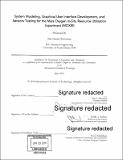| dc.contributor.advisor | Jeffrey A. Hoffman. | en_US |
| dc.contributor.author | Hinterman, Eric Daniel | en_US |
| dc.contributor.other | Massachusetts Institute of Technology. Department of Aeronautics and Astronautics. | en_US |
| dc.date.accessioned | 2018-11-28T15:42:13Z | |
| dc.date.available | 2018-11-28T15:42:13Z | |
| dc.date.copyright | 2018 | en_US |
| dc.date.issued | 2018 | en_US |
| dc.identifier.uri | http://hdl.handle.net/1721.1/119301 | |
| dc.description | Thesis: S.M., Massachusetts Institute of Technology, Department of Aeronautics and Astronautics, 2018. | en_US |
| dc.description | Cataloged from PDF version of thesis. | en_US |
| dc.description | Includes bibliographical references (pages 79-80). | en_US |
| dc.description.abstract | The Mars Oxygen In-Situ Resource Utilization Experiment (MOXIE) represents the first time that NASA is demonstrating In-Situ Resource Utilization (ISRU) on the surface of another planetary body. MOXIE will produce oxygen from atmospheric CO 2 on Mars. It is being developed for NASA's 2020 Mars Rover and will produce greater than 99.6% pure oxygen through solid oxide electrolysis. MOXIE is roughly 0.5% of the scale that would be necessary to produce oxygen for breathing and use as a propellant for a human Mars mission. Tests are being performed on MOXIE in the laboratory at NASA's Jet Propulsion Laboratory (JPL) and the Massachusetts Institute of Technology (MIT). At the same time, a model is being developed to simulate and predict the performance of MOXIE. The ability to predict the performance of MOXIE on Mars is a critical step in preparation for surface operations. Without the ability to estimate inefficient or unsafe operating conditions, MOXIE operations on Mars run a spectrum of risk ranging from loss of efficiency to the loss of the entire mission. Therefore, to predict performance and thus avoid subjecting flight hardware to unsafe conditions, a dynamic model has been developed that simulates MOXIE's operation. Simulink, a package contained within the MATLAB programming language, was chosen as a convenient way to build a dynamic representation of MOXIE. The model was built as a combination of theoretical and empirical values regarding the gas flows, thermal transfers, electrochemistry, and control loops that are representative of the true MOXIE system. The results of this model have been validated against data from JPL's MOXIE testbed laboratory. Continued model validation will occur as JPL acquires new data throughout 2018. This thesis gives an overview of how MOXIE works and how it has been modeled. MOXIE is the first instrument of its kind to leave the Earth, and the modeling of this instrument is similarly unique. As the dynamic model continues to evolve with new data, it becomes a fast and inexpensive way to test MOXIE without subjecting expensive hardware to hazardous conditions. In addition, this thesis covers the development of a Graphical User Interface (GUI) that allows users to easily control the model and view its outputs. Finally, the design and results of construction of a vacuum chamber for testing of MOXIE components are presented. These tests will help to further validate the model and will pave the way for extensibility studies of the MOXIE system. | en_US |
| dc.description.sponsorship | Supported with the NASA Space Technology Research Fellowship | en_US |
| dc.description.statementofresponsibility | by Eric Daniel Hinterman. | en_US |
| dc.format.extent | 80 pages | en_US |
| dc.language.iso | eng | en_US |
| dc.publisher | Massachusetts Institute of Technology | en_US |
| dc.rights | MIT theses are protected by copyright. They may be viewed, downloaded, or printed from this source but further reproduction or distribution in any format is prohibited without written permission. | en_US |
| dc.rights.uri | http://dspace.mit.edu/handle/1721.1/7582 | en_US |
| dc.subject | Aeronautics and Astronautics. | en_US |
| dc.title | System modeling, graphical user interface development, and sensors testing for the Mars Oxygen In-Situ Resource Utilization Experiment (MOXIE) | en_US |
| dc.type | Thesis | en_US |
| dc.description.degree | S.M. | en_US |
| dc.contributor.department | Massachusetts Institute of Technology. Department of Aeronautics and Astronautics | |
| dc.identifier.oclc | 1061859928 | en_US |
